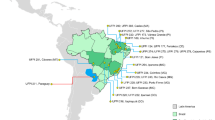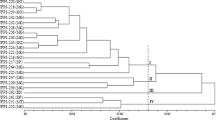Abstract
The genetic variability of 46 accessions of the Lima bean (P. lunatus L.) including 16 wild forms and 30 landraces belonging to the three cultigroups Big lima, Sieva, Potato, and their intermediates, was evaluated using RAPD (Random amplified polymorphic DNA) markers. Twelve oligonucleotide primers produced 172 RAPD markers which allowed the differentiation of two main groups: the mesoamerican and the andean groups. This was confirmed by an AMOVA analysis which indicated that 37.7% of the variation was found between these two groups. For each botanical form (wild and cultivated), the molecular markers showed that small-seeded types (i.e. Sieva and Potato types and their related wild forms) had a wide distribution (from Mexico to Argentina) while the large-seeded types (Big lima type and its related wild forms) were circumscribed to the narrow west-coastal region from Ecuador to Bolivia. The results are in favour of an independent domestication process within the two groups, as the differentiation between mesoamerican and andean accessions was found to occur in both wild forms and landraces. Within each of the two main groups, wild forms and landraces were also found to be genetically differentiated and higher genetic diversity was observed among landraces than among wild forms. Within the mesoamerican landraces, low but significant differentiation between the Sieva and Potato cultigroups was observed. Some suggestions and hypotheses are discussed about evolution of the two small-seeded types.
Similar content being viewed by others

References
Baudet, J.C., 1977. Origine et classification des espèces cultivées du genre Phaseolus. Bull Soc Roy Bot Belg 106: 53–59.
Baudoin, J.P., 1990. L'amélioration de Phaseolus lunatus L. en zone tropicale. 5. Génétique, biologie florale et évolution des accessions. Bull Rech Agron Gembloux 25: 281–312.
Brown, A.D.H., 1978. Isozymes, plant accession genetic structure and genetic conservation. Theor Appl Genet 52: 145–157.
Chandelier, A., 1995. Structure du genome mitochondrial de l'épicéa commun (Picea abies (L.) Karst) lors de l'embryogenèse somatique in vitro. Thèse Doct Sci Agron, Fac Univ Sci Agron Gembloux (Belgique).
Clark, A.G. & C.M.S. Lanigan, 1993. Prospects for estimating nucleotide divergence with RAPDs. Mol Biol Evol 10: 1096–1111.
Debouck, D.G., J.H. Linan Jara, S.A. Campana & J.H. De la Cruz Rojas, 1987. Observations on the domestication of Phaseolus lunatus L. FAO/IBPGR Plant Genet Res Newsl 70: 26–32.
Debouck, D.G., 1986a. Primary diversification of Phaseolus in the Americas: Three centres? FAO/IBPGR Plant Genet Res Newsl 67: 2–8.
Debouck, D.G., 1986b. Phaseolus germplasm collection in the Huasteca and surrounding regions, Mexico. Trip report. Mimeographed CIAT, Cali, Colombia.
Debouck, D.G., A. Maquet & C.E. Pesso, 1989. Biochemical evidence for two different gene pools in Lima bean, Phaseolus lunatus L. Ann Rpt Bean Improvement Coop 32: 58–59.
Delgado, S.A., 1985. Systematic of the genus Phaseolus (Leguminoseae) in North and Central America. PhD thesis. University of Texas, Austin, USA.
Excoffier, L., P.E. Smouse & J.M. Quarttro, 1992. Analysis of molecular variance inferred from metric distances among DNA haplotypes: application to human mitochondrial DNA restriction data. Genetics 131: 479–491.
Felsenstein, J., 1993. PHYLIP (Phylogeny Inference Package) version 3.5c. Distributed by the author. Department of Genetics, University of Washington, Seattle.
Gepts, P., 1988. Phaseolin as an evolutionary marker. In: P. Gepts (Ed.), Genetic Resources of Phaseolus Bean, pp. 215–241. Kluwer Academic Publishers, Dordrecht, The Netherlands.
Gepts, P., 1991. Genetic diversity in Phaseolus lunatus using electrophoretic analysis of phaseolin. Final Rpt. IBPGR 91/11.
Gepts, P., S.P. Singh, V.B. Velasquez, E.M.K. Koinange, G. Sonnante & T. Stockton, 1993. The genetics of domestication in common bean. In: W.M. Roca, J.E. Mayer, M.A. Pastor-Corrales & J. Tohme (Eds.), Proceeding of the Second International Scientific Meeting, pp. 25–35. Phaseolus Beans Advanced Biotechnology Research Network (BARN)-CIAT, Cali, Colombia.
Gutiérrez, S.A., P. Gepts & D.G. Debouck, 1995. Evidence for two gene pools of the Lima beans, Phaseolus lunatus L., in the Americas. Genet Res Crop Evol 42: 15–28.
Kaplan, L. & L.N. Kaplan, 1988. Phaseolus in archeology. In: P. Gepts (Ed.), Genetic Resources of Phaseolus Bean, pp. 125–142. Kluwer Academic Publishers, Dordrecht, The Netherlands.
Kaplan, L., 1965. Archeology and domestication in American Phaseolus (bean). Econ Bot 19: 358–368.
Katanga, K. & J.P. Baudoin, 1990. Analyses méiotiques des hybrides F1 et études des descendances F2 chez quatre combinaisons interspécifiques avec P. lunatus. Bull Rech Agron Gembloux 25: 237–250.
Koenig, R. & P. Gepts, 1989. Allozyme diversity in wild P. vulgaris: further evidence for two major centers of genetic diversity. Theor Appl Genet 78: 809–817.
Le Marchand, G. & R. Maréchal, 1977. Chromosome pairing in interspecific hybrids reveals the value of pollen morphology for deducting phylogenic affinities in the genus Phaseolus. In: Proc 8th Congress Eucarpia. Interspecific hybridization in plant breeding, Madrid, pp. 335–337.
Lioi, L. & C. Lotti, 1996. Allozyme variability in cultivated Lima bean (Phaseolus lunatus L.). Ann Rpt Bean Improvement Coop 39: 249–250.
Llaca, V., A.S. Delgado & P. Gepts, 1994. Chloroplastic DNA as an evolutionary marker in Phaseolus vulgaris complex. Theor Appl Genet 88: 646–562.
Mackie, W.W., 1943. Origin, dispersal and variability of the Lima bean, Phaseolus lunatus. Hilgardia 15: 1–29.
Maquet, A., 1995. Etude de la diversité génétique de la légumineuse alimentaire Phaseolus lunatus L. par l'analyse de caractères morphophysiologiques et de marqueurs protéiques. Thèse de Doctorat en Sciences Agronomiques, Faculté Universitaire des Sciences Agronomiques de Gembloux (Belgique).
Maquet, A., 1991. Lima bean (Phaseolus lunatus L.). Catalogue, CIAT, Cali, Colombia (1991).
Maquet, A., A. Gutiérrez & D.G. Debouck, 1990. Further biochemical evidence for the existence of two gene pools in Lima bean. Ann Rpt Bean Improvement Coop 33: 128–129.
Maquet, A., I. Zoro BI, O.J. Rocha & J.P. Baudoin, 1996. Case studies on breeding systems and its consequences for germplasm conservation. 1. Isoenzyme diversity in wild Lima bean populations in central Costa-Rica. Genet Res Crop Evol 43: 309–318.
Maréchal R., J.M. Masherpa & F. Stainier, 1978. Etude taxonomique d'un groupe complexe d'espèces des genres Phaseolus et Vigna (Papilionaceae) sur la base de données morphologiques et polliniques, traitées par l'analyse informatique. Boissiera, 28: 273 p.
Murray, M.G. & W.F. Thompson, 1980. Rapid isolation of high molecular weight plant DNA. Nucl Acids Res 8: 4321–4325.
Nei, M. & W.H. Li, 1979. Mathematical model for studying genetic variation in terms of restriction endonucleases. Proc Natl Acad Sci USA 76: 5269–5273.
Nienhuis, J., J. Tivang & P. Skroch, 1995. Genetic relationships among cultivars and landraces of Lima bean (P. lunatus L.) as measured by RAPD markers. J Amer Soc Hort Sci 120: 300–306.
Pastor-Corrales, M.A., 1996. Traditional and molecular confirmation of the coevolution of beans and pathogens in Latin America. Ann Rpt Bean Improvement Coop 39: 46–47.
Schmit, V., P. du Jardin, J.P. Baudoin & D.G. Debouck, 1993. Use of chloroplast DNA polymorphism for the phylogenetic study of seven Phaseolus taxa including P. vulgaris and P. coccineus. Theor Appl Genet 87: 506–616.
Singh, S.P., R. Nodari & P. Gepts, 1991. Genetic diversity in cultivated common bean: I. Allozymes. Crop Sci 31: 19–23.
Smartt, J., 1970. Interspecific hybridization between cultivated American species of the genus Phaseolus. Euphytica 19: 480–489.
Smartt, J., 1990. Grain legumes. Evolution and genetic resources. Cambridge University Press, 1990.
Stewart, C.N. & L. Excoffier, 1996. Assessing population genetic structure and variability with RAPD data: application to Vaccinium macrocarpon (American cranberry). J Evol Biol 9: 153–171.
Sullivan, J.G. & G. Freytag, 1986. Predicting interspecific compatibilities in beans (Phaseolus) by seed protein electrophoresis. Euphytica 35: 201–209.
Author information
Authors and Affiliations
Rights and permissions
About this article
Cite this article
Fofana, B., Vekemans, X., du Jardin, P. et al. Genetic diversity in Lima bean (Phaseolus lunatus L.) as revealed by RAPD markers. Euphytica 95, 157–165 (1997). https://doi.org/10.1023/A:1002910114869
Issue Date:
DOI: https://doi.org/10.1023/A:1002910114869



